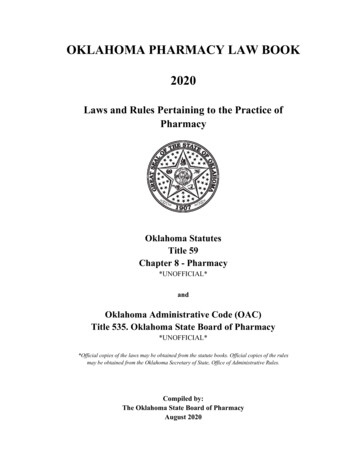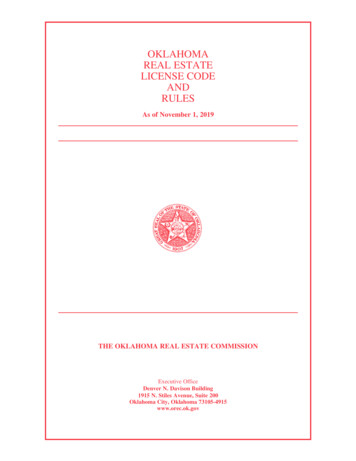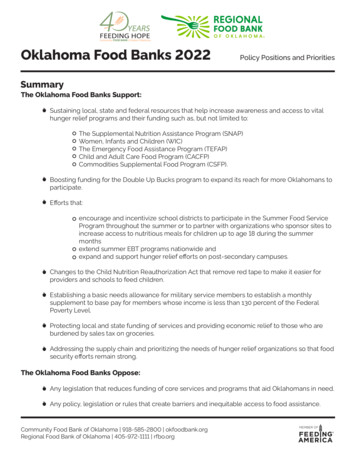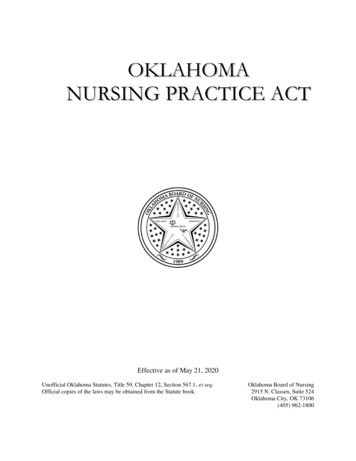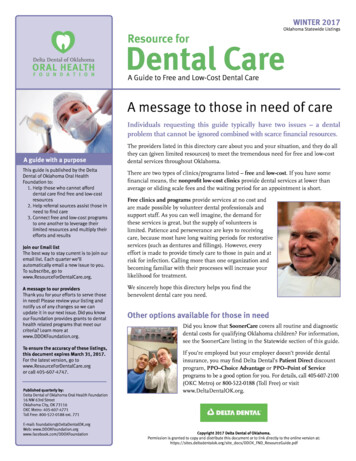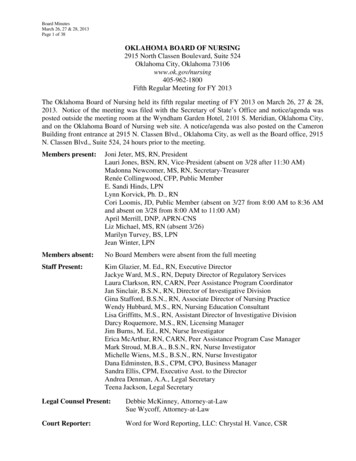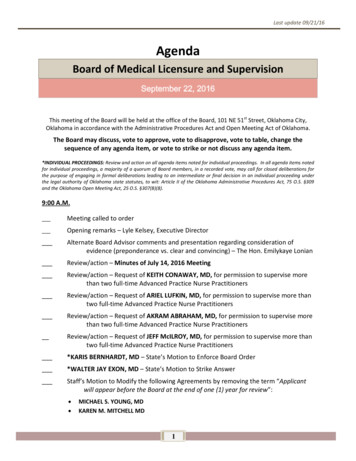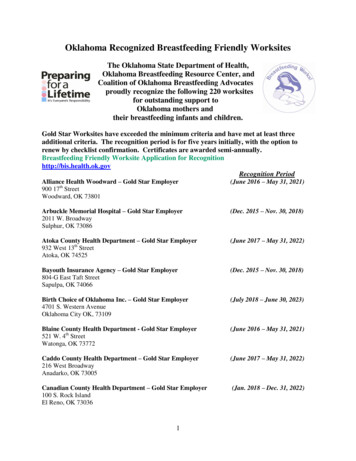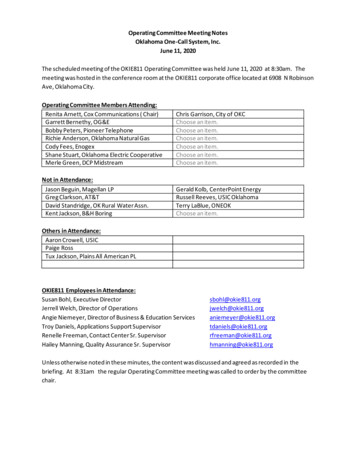
Transcription
PERFORMANCEMANAGEMENT PROCESSIt is not merely evaluation.STATE OF OKLAHOMATRAINING AND DEVELOPMENTOFFICE OF MANAGEMENT AND ENTERPRISE SERVICESHUMAN CAPITAL MANAGEMENT
About HCM Training and DevelopmentMembers of the Human Capital Management (HCM) Training& Development Team assess the supervisory and managerialtraining and development needs of state employees and developand administer training courses and developmental activities tomeet those needs. Team members also coordinate efforts amongstate agencies to share training and educational resources.This publication was printed by the Office of Management and Enterprise Services as authorized by Title 62, Section 34.200 copies have been printed at a cost of 560. A copy has been submitted to Documents.OK.gov in accordance with theOklahoma State Government Open Documents Initiative (62 O.S. § 34.11.3). This work is licensed under a Creative Attribution-NonCommercial-NoDerivs 3.0 Unported License.
TABLE OF CONTENTSPerformance Management Process1Planning Phase Overview2Write S.M.A.R.T. Goals3Set Performance Standards5Define Behaviors9Coaching Phase Overview15Provide Feedback16Give Effective Feedback17Reviewing Phase Overview19Avoid Rater Bias20Legal Requirements21Tips for Evaluations and Meetings23Final Checklist25Sources263
Performance Management ProcessPerformance management is a communication process by whichmanagers and employees work together to plan, monitor andreview an employee’s work objectives and overall contributionto the organization. More than just an annual performancereview, performance management is the continuous processof setting objectives, assessing progress and providing ongoingcoaching and feedback to ensure that employees are meeting theirobjectives and career goals.NRE1COHACPL AThere is much more to performance management than theannual performance review meeting. Performance managementis a continuous process of planning, coaching and reviewingemployee performance.VIE W
Planning Phase OverviewThe planning phase is a collaborative effort involving bothmanagers and employees during which they will:ӹ Review the employee’s job description to determine if it reflectsthe work that the employee is currently doing.ӹ Identify and review the links between the employee’s jobdescription, his or her work plan, and the organization’s goals,objectives and strategic plan.ӹ Develop a work plan that outlines the tasks or deliverablesto be completed, the expected results and the measures orstandards that will be used to evaluate performance.ӹ Identify critical areas that will be key performance objectivesfor the year. The choice of areas may be determined by theorganization’s strategic plan, by the employee’s desire toimprove outcomes in a certain part of his or her job or by aneed to emphasize a particular aspect of the job.ӹ Identify training objectives that will help the employee growhis or her skills, knowledge and competencies related to thework.ӹ Identify career development objectives that can be part oflonger-term career planning.2
Write S.M.A.R.T. GoalsOften, the most difficult part of the planning phase is developingclear and appropriate language to describe performance objectivesand measures or indicators of success. Supervisors need to ensurethat the performance objectives are a good representation ofthe full range of duties carried out by the employee, especiallyeveryday tasks that take time, but are often not identified assignificant accomplishments.The objectives and indicators need to be S.M.A.R.T.SPECIFICSClearly specify the task to be done, when it must be completed, who is toaccomplish it, and how much is to be accomplished.MEASUREABLEMUse multiple measures if possible, for example, quantity, quality, timeframe and cost. Ask questions such as: How much? How many? Howwill I know when it is accomplished?ATTAINABLEAEnsure there is a reasonable path to achievement and an excellentchance that objectives will be accomplished.RELEVANTRGoals should be aligned with the organization’s overall mission orstrategy. Goals measure outcomes, not activities.TIME BASEDTSet a clear time frame for achieving performance objectives/goals. Inmost cases, objectives must be completed by the end of the performancereview period.3
EXAMPLEWell-Written Performance Objective/GoalBy Sept. 10, 2013, use instructional system design methodologies todesign and develop a one-day PMP course for state employees, soparticipants are able to constructively build their knowledge aboutthe performance management process in the course being offered infall 2013.SPECIFICMEASUREABLEATTAINABLEWhat: Design and develop a one-day PMP course for stateemployees.How: Use instructional system design methodologies.Why: So participants are able to constructively build theirknowledge about the performance management process in thecourse being offered in fall 2013.The metric (measure) is whether the course is ready by Sept. 10,2013, and whether the goal is met. More details are available inthe following section, Set Performance Standards.The employee must be knowledgeable in the area of instructionaldesign to understand the nature of the goal. Additionally, in orderto remain interested and committed to accomplishing the goal, itmust present a challenge to the employee.The goal is aligned with the overal mission of the organization.RELEVANTSept. 10, 2013, provides a time-bound deadline.TIME BASED4
Set Performance StandardsWhile goals tell employees what they have to do, performancestandards tell them how well they have to do it. Listed beloware some principles of writing good standards that can be usedeffectively to evaluate employee performance:Quality: addresses how well the work is performed and/or howaccurate or how effective the final product is. Quality refers toaccuracy, appearance, usefulness or effectiveness.Quantity: addresses how much work is produced. A quantitymeasure can be expressed as an error rate, such as number orpercentage of errors allowed per unit of work or as a generalresult to be achieved. When a quality or quantity standard is set,the criteria for Exceeds Standards should be high enough to bechallenging, but not so high that it is unattainable.Timeliness: addresses how quickly, when or by what date thework must be produced. Timeliness standards should be setrealistically.Cost-effectiveness: addresses dollar savings to the organizationor working within a budget. Cost-effectiveness standards mayinclude such aspects of performance as maintaining or reducingunit costs, reducing the time it takes to produce a product or serviceor reducing waste.Manner: addresses the way or style in which a task is performedor produced.5
ASK YOURSELFSupervisors should apply at least two characteristicsto each of the objectives/goals. Decide which type of performancestandards are important to the performance of the task by askingthe following questions:Is quality important? Does the stakeholder or customer carehow well the work is done?Is quantity important? Does the stakeholder or customer carehow many are produced?Is it important that the task be accomplished by a certain time?Is it important that the task is completed within certain costlimits?Is it important that the task is completed in a certain manner?6
EXAMPLEPerformance Standards for AnsweringPhone Calls and EmailsThe following examples illustrate how performance objectives/goals areenhanced by the use of strong Performance Standards:Every effort should be made to respond to allvoicemail messages the same business day. When thisis not possible, messages should be returned no laterthan the following business day.All email inquiries or requests for information mustreceive a response within 24 hours. In the event theinformation requested is not immediately available, acourtesy response acknowledging the request/inquirymust be sent within 24 hours along with a messageindicating when the requested information can beforwarded.Customer requests/inquiries often require additionalresearch or consultation. The representative whoreceived the request/inquiry is responsible forresearching the issue or consulting with appropriateteam members and providing a response to thecustomer.In some cases, a representative is unable to assist acustomer with a request/inquiry. When this occurs,the call must be transferred to another representative.Department procedures require the representativetransferring the call to remain on the line with thecustomer until the other representative answers thecall and confirms the ability to assist the customer.7
EXAMPLEPerformance Standards for filling aVacant PositionTime to fill: Vacant staff positions should be filled within a 45-daytimeframe. This deadline may vary depending on the complexitylevel of the position and the availability of hiring officials.Employment requisition and posting process: When arequisition is received at HCM Recruiting, the position is posted tothe agency website within 24 hours. If there are reasons why thiscannot occur or questions that must be answered first, the recruitermust contact the hiring department no later than the next businessday following the submission of a requisition.Recruiting process: All open positions are posted on our websitefor a minimum of seven calendar days, which must include fivebusiness days. Resumes are screened by HCM Recruiting on aweekly basis unless a request is made by the hiring manager formore or less frequently.Hiring process: Offers of employment are extended by therecruiter only upon the candidate’s satisfactory completion of abackground screening. Background screenings typically take 3-5business days depending on the receipt of results from criminalbackground checks and the availability of professional references.8
Define BehaviorsWith the PMP, all employees will be rated on the followingbehaviors:CUSTOMER SERVICEORIENTATIONPROBLEM SOLVINGINITIATIVEExceeds StandardsTEAMWORKLEADERSHIPMeets StandardsDoes Not Meet StandardsOBSERVING WORKHOURS/USING LEAVEMeets StandardsDoes Not Meet StandardsRating for Leadership should be reserved for employees whoare in a position to demonstrate this behavior. Leadership is notequivalent to being a supervisor of other workers. Following aresome questions a supervisor and employee should discuss duringthe Planning Session to decide whether this Behavior applies:ӹ Does the job involve training other employees, even newlyhired people at the same level?ӹ Do customers (external customers, co-workers and peoplein other agencies) turn to the employee in this position forexpertise on projects?ӹ Does the employee act as a leader on various projects withinthe agency and deserve recognition for these contributions?9
EXAMPLECustomer Service OrientationCustomer service is a series of activities designed to enhance thelevel of customer satisfaction – that is, the feeling that a product orservice has met the customer’s expectation.Behaviors that might be rated Meets Standards include:ӹ Develops a clear understanding of customers’ needs andgoalsӹ Maintains clear communication with customersregarding expectations and time framesӹ Follows through and responds to customers’ requests,questions, and complaints in a timely mannerӹ Follows up with customers after a problem has beenresolved to inform them of any action takenӹ Takes personal responsibility for meeting commitmentsand correcting problemsӹ Responds calmly under pressure10
EXAMPLETeamworkA team player is one who puts personal goals second to team goalsand works in coordination with other members of a group or teamto reach a common goal.Examples of behaviors that might be rated Meets Standards include:ӹ Offers to help and pitches in to get the job doneӹ Does not hesitate to praise and give credit to the projectteam for a job well doneӹ Keeps others informed and up-to-date about tasks orprojectsӹ Gives support to others by providing detailedinstructions or clarificationsӹ Works effectively with others to resolve common issuesor problemsӹ Listens to and seeks input from others on how tocomplete work assignments or accomplish goals11
EXAMPLEProblem Solving InitiativeEmployees are expected to take initiative to efficiently solve all kindsof problems related to their work.Examples of behaviors that might be rated Meets Standards include:ӹ Solves problems timelyӹ Identifies the causes of problems and finds the necessaryresources and information to resolve themӹ Uses experience to recognize immediate problems andissuesӹ Breaks problems down into lists of tasks, issues oractivitiesӹ Sets priorities on tasks and activities that compete forattentionӹ Recognizes when information is missing, incomplete orinaccurateӹ Understands and is able to discuss the logical sequenceof events when solving problems or working on a projectӹ Revises priorities based on changing needs or newrequests12
EXAMPLELeadershipLeadership is the art of leading and influencing others todeliberately create a result that wouldn’t have happened otherwise.Examples of behaviors that might be rated Meets Standards include:ӹ Sets priorities to align work with and in support ofagency or division goalsӹ Plans and leads meetings to ensure that issues arediscussed and agendas are followedӹ Provides others with timely and accurate feedbackӹ Accesses resources in a timely mannerӹ Recommends changes in work methods to improveperformance within the agency or divisionӹ Solicits the opinions, ideas, and recommendations ofothers in improving the work situation13
EXAMPLEObserving Work Hours/Using LeaveExamples of behaviors that might be rated Meets Standards include:ӹ Arrives at work on timeӹ Is punctual with lunch hour and break periodsӹ Makes productive use of work time and focuses on assignedduties and tasksӹ Ensures work does not suffer if personal business interrupts thework dayӹ In use of sick leave, notifies supervisor in a timely manner inaccordance with agency policyӹ Considers work flow issues when requesting annual leave ortaking break periods14
Coaching Phase OverviewPerformance management includes coaching employees toaddress concerns and issues related to performance so thatthere is a positive contribution to the organization. Monitoringday-to-day performance does not mean watching over everyaspect of how employees carry out assigned activities and tasks.Managers should not micro-manage employees, but rather focustheir attention on results achieved, as well as individual behaviorsand team dynamics affecting the work environment.During this phase, the employee and supervisor should meetregularly to:ӹ Assess progress made toward meeting performance objectivesӹ Identify barriers that may prevent an employee fromaccomplishing performance objectives and what can be doneto overcome themӹ Share feedback on progress relative to the goalsӹ Identify changes in the work plan that may be required as aresult of a shift in organization priorities or when an employeeis required to take on new responsibilitiesӹ Determine if any extra support is required from the managersor others to assist the employee in achieving his or herobjectives15
Provide FeedbackFeedback is specific information provided to the employee thatcommunicates how the employee’s behavior is affecting theworkplace. Feedback can be factual (based on observationsof the employee’s behavior and its resulting consequences) oremotional (based on how other people react to the employee’sbehavior). Ideally, both types of feedback should be shared withthe employee in a feedback meeting.Positive feedback involves telling an employee about goodperformance. Make this type of feedback timely, specific, andfrequent as recognition for effective performance is a powerfulmotivator.Constructive feedback alerts an employee to areas in needof improvment. Feedback should be descriptive, detailed, andfocused on the action, not the person. The main purpose isto help people understand where they stand in relation to theexpected performance and behaviors.If an employee is not meeting performance expectations,managers need to provide constructive and honest feedback. It’simportant to do this before an issue escalates into a significantproblem. On the next few pages, you will find a few points toconsider when giving constructive feedback.16
Give Effective FeedbackPrepare and State the Factsӹ Consider the issue(s) you want to address in the meeting andconfirm the facts of the performance or behavior problem. Makesure you know and can describe the details of the event(s) thatnecessitated the coaching session.ӹ Select a meeting location that provides privacy and minimalinterruptions.ӹ Approach the discussion calmly with objectivity and clarity.ӹ Speak in a non-threatening tone.ӹ Describe performance or behavior issues in an objective, factual,and nonjudgmental fashion.ӹ Provide specific examples.ӹ Identify the impact the employee’s actions/behaviors have oncoworkers or the organization as a whole.EXAMPLEConsider the differences in the followingstatements:“You are always late.”: This statement is general and judgmental. Itdoes not address the performance issue effectively.“You were late 3 times last week. When you arrived late for thestaff meeting, you missed an important discussion about our newfundraising campaign.”: This statement is factual and specificallyaddresses the performance issue and the impact of being late.17
Listenӹ Have the employee describe the situation from their perspectiveand provide an explanation. Be open to any new insights thatmight be relevant to the issue.ӹ Respond to denial, blaming of others, etc., by restating factualinformation and the effects of the performance or behavior issueon co-workers or the organization.Although we may sympathize with an employee’s unique personalcircumstances and their reasons for poor performance, it isimportant to remain focused on the performance issue. If you alterwhat is required of one employee, i.e., bend the rules, you haveto be prepared to do so for all employees. As a supervisor, try toavoid placing yourself in a position that requires you to judge whichcircumstances warrant special treatment and those that do not.Agree on an Action Planӹ Ask the employee to suggest a plan that addresses theissue and offer your suggestions when necessary.ӹ Agree on a specific plan of action that details the steps theemployee must take toward improvment, the plan to implementchange and the agreed upon time frame for completing theaction plan.ӹ Document the action plan and keep it in the employee’sperformance management file. If the plan also serves as a type offormal discipline, it must be placed in the employee’s personnelfile as well.ӹ Specify the consequences to the employee if the performance/behavior issue is not resolved.18
Reviewing Phase OverviewThe performance assessment or appraisal meeting is anopportunity to review, summarize and highlight the employee’sperformance over the course of the review period.Self-assessment is a standard part of most performanceappraisals. By using the performance plan and assessment form asa guide, employees can evaluate their performance in preparationfor the appraisal meeting. This process can help identify gapsbetween the employee’s self-perceptions and the manager’s viewsand facilitate an in-depth discussion of performance issues.Managers should review their performance management notesand other documentation generated throughout the year in orderto more effectively assess the employee’s performance. Only issuesthat have previsouly been discussed with the employee shouldbe part of the assessment documentation and meeting. Thishelps ensure managers address performance issues as they ariseand assures the employee there will be no surprises during theperformance assessment meeting.ӹ Summarize the work accomplished relative to the goals setat the beginning of the performance period. This includescapturing key results, accomplishments and shortfalls foreach objective.ӹ Document challenges encountered during the year andidentify areas for training and/or development.ӹ Identify and discuss any unforeseen barriers to the achievementof the objectives.19
Avoid Rater BiasOur judgments about many things are affected by our perception.When a person evaluates someone else, his or her evaluationreflects not only the person being assessed but also their ownbuilt-in biases. Managers should be aware of their possibleevaluation biases so they can work to eliminate them from theassessment process.Some common biases include:Halo: A tendency to form a generalized positive impression ofan employee, e.g., rating the employee highly on all criteria ratherthan independently rating each item.Horns: The tendency to form an overall negative impressionof an employee that results in artificially low ratings. This is theopposite of the halo effect bias.Central tendency: A tendency to use only the mid-point ofthe rating scale.Leniency bias/Strictness bias: A tendency to be morelenient or more strict than one’s peers when evaluatingemployees, or to be more lenient or strict with one employeewhen compared to another.Same-as-me: A tendency to rate employees who are perceivedto be similar to the rater more favorably than employees whoappear dissimilar. IMPORTANT: If this tendency is based ongrounds for discrimination under human rights legislation (forexample race, gender, nationality), it is a violation of humanrights, and it is illegal.20
LEGAL REQUIREMENTSӹ State employees must use the form provided by OMES HCMfor employee evaluations.ӹ The immediate supervisor of the employee must perform theevaluation.ӹ A performance evaluation must be conducted for every regular,classified and unclassified employee. Each agency is allowedthree specific exempt positions: executive director, principalassistant or deputy director and executive secretary. Only afew executive branch entities are wholly exempt. Temporaryemployees are not required to be evaluated.ӹ Evaluations must be performed annually based on a 12-monthevaluation period. More frequent evaluations are allowed, butan evaluation period longer than 12 months is not acceptable.ӹ Supervisors must identify accountabilities and behaviorsapplicable to each employee and communicate them to theemployee. A copy of the planning PMP must be provided tothe employee.ӹ Supervisors must hold a meeting with each employee for a midyear review of performance to that point.ӹ Supervisors must identify performance strengths and areas fordevelopment in the final evaluation.21
ӹ Supervisors must hold a meeting with each employee to reviewand discuss the final evaluation. Each employee must be providedwith a copy of the evaluation.ӹ Employees must be given the opportunity to provide writtencomments regarding their evaluations.ӹ Classified employees who are in probationary status must receivean evaluation at least 30 days prior to the end of the probationaryperiod.ӹ Supervisors must not consider leave taken in accordance withthe Family and Medical Leave Act (FMLA) when rating ObservingWork Hours and Using Leave. Additionally, FMLA taken mustnot influence any other ratings given.22
TIPS FOR EVALUATIONSAND MEETINGSӹ Give specific examples to support your ratings.ӹ Be realistic about past accomplishments and future goals.ӹ Avoid references to age, race, ethnicity, gender or disability.ӹ Avoid implied promises.ӹ Consider the performance during the entire review period andnot just the performance during the last few months.ӹ Avoid the use of other people’s names during performancereviews; use job titles and organizational names.ӹ Ensure each employee understands the criteria on which he orshe is being evaluated.ӹ Reevaluate goals with each employee a few months prior to thefinal evaluation. Modify goals as necessary to reflect shiftingpriorities or responsibilities.ӹ Keep notes on the performance of employees throughout theyear; save emails or other correspondence that document good orbad performance. Keep notes on when activities were completedand on the circumstances of absences or disciplinary actions.ӹ Allow employees to evaluate their own performance.ӹ Treat a performance review meeting as a focused businessmeeting, and keep all conversations confidential.23
ӹ Show respect to each employee by preparing for the performancereview. Schedule meetings at least a week in advance at a time thatis convenient for the employee. Conduct performance reviewsin a private office or conference room. Have all documentationcompleted and provide a copy to the employee.ӹ Do not wait until the meeting to inform an employee ofunsatisfactory performance. There should be no surprise issuesraised during the meeting.ӹ Maintain a professional approach when completing yourevaluation documentation. Remember this document can be usedas evidence in grievance hearings and other legal proceedings.Do not include humorous anecdotes, personal information,judgmental statements or offensive or discriminatory language.ӹ Include all pertinent information. Do not omit informationbecause it is uncomfortable to discuss or potentially contentious.ӹ Keep control of the meeting. Do not enter into a debate with anemployee. As the supervisor, you make the decisions about theratings, and if you have been fair in your assessment, you muststand by your rating.ӹ Provide a copy of the evaluation to each employee prior tothe meeting, allowing time to review your ratings/comments.Begin the meeting by providing a recap of the employee’soverall performance in a positive and supportive manner.Next, explain that the remainder of the meeting will focus onaccomplishments, areas of concern and setting future goals.ӹ Encourage employees to share their thoughts and suggestions.Be open-minded and look for opportunities for improvement.24
FINAL CHECKLISTAs stated previously, performance management has a variety ofpurposes, one of which is documentation should there be a legalchallenge related to performance. To ensure that your performancemanagement process is fair and defensible:ӹ Base each evaluation on well written job descriptions and jobrelated activities.ӹ Collaborate with employees when setting objectives.ӹ Develop observable measures for the established objectives/goalsand behaviors.ӹ Ensure employees keep a copy of the initial PMP documentwhich includes the expectations set at the beginning of theperformance management cycle.ӹ Provide employees with ongoing monitoring and feedback onperformance.ӹ Provide support (training, coaching, etc.) and adequate timefor improvement when performance problems are identified.ӹ Work to reduce biases and errors in assessments.ӹ Ensure the performance assessment form accurately documentsperformance.ӹ Periodically review the performance management process toensure it is applied consistently and fairly.25
ӹӹ Show respect to each employee by preparing for the performancereview. Schedule meetings at least a week in advance at a time thatis convenient for the employee. Conduct performance reviewsin a private office or conference room. Have all documentationcompleted and provide a copy to the employee.ӹӹ Do not wait until the meeting to inform an employee ofunsatisfactory performance. There should be no surprise issuesraised during the meeting.ӹӹ Maintain a professional approach when completing yourevaluation documentation. Remember this document can be usedas evidence in grievance hearings and other legal proceedings.Do not include humorous anecdotes, personal information,judgmental statements or offensive or discriminatory language.ӹӹ Include all pertinent information. Do not omit informationbecause it is uncomfortable to discuss or potentially contentious.ӹӹ Keep control of the meeting. Do not enter into a debate with anemployee. As the supervisor, you make the decisions about theratings, and if you have been fair in your assessment, you muststand by your rating.ӹӹ Provide a copy of the evaluation to each employee prior tothe meeting, allowing time to review your ratings/comments.Begin the meeting by providing a recap of the employee’soverall performance in a positive and supportive manner.Next, explain that the remainder of the meeting will focus onaccomplishments, areas of concern and setting future goals.ӹӹ Encourage employees to share their thoughts and suggestions.Be open-minded and look for opportunities for improvement.24
Sourcesӹ Performance Management Process Manual of the State ofOklahomaӹ HR Council (hrcouncil.ca)ӹ HR Department of the University of Virginiaӹ HR Department of Case Western Reserve University26
Notes27
State of OklahomaTraining and DevelopmentOMES Human Capital Management2101 N. Lincoln Blvd.Oklahoma City, Ok 73105Office: (405)522-6334Fax: (405)524-6942OMES.OK.GOV
Performance Management Process Performance management is a communication process by which managers and employees work together to plan, monitor and review an employee’s work objectives and overall contribution to the organization. More than just an annual performance

